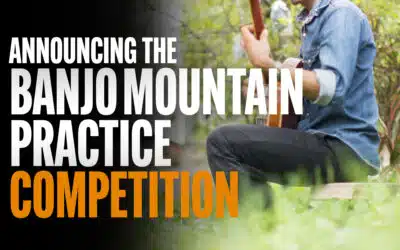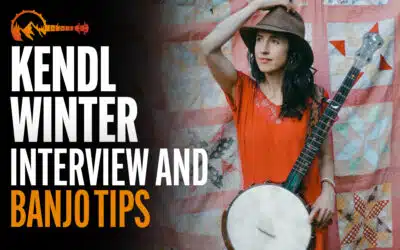How does one make the leap from playing banjo songs alone to being able to improvise off the cuff with virtually any song thrown your way?
Having been a banjo instructor for decades, this is one of the most common questions I hear.
Stated another way: how do I move from learning and playing songs via tablature to being able to pick spontaneously with other players? And how can I improvise with tunes I am unfamiliar with. Is this possible simply by learning to play and memorize tabbed-out arrangements of banjo tunes? The answer to this last question is “no.”
While learning to play bluegrass and clawhammer banjo via tabbed-out songs is an essential part of learning the instrument, it’s only one piece of the puzzle.
There is another component that is vital in the “How-do-I-to-learn-to-play-banjo” equation. It is also, sadly, one of the most overlooked. What is this magic bullet, you ask? It is the act of observing and participating in a bluegrass or clawhammer jam.
Don’t misunderstand me – I’m not saying all you have to do is go to a few jams and magically you’ll be able to play like Earl Scruggs.
What I AM saying is that in order to be conversant in banjo you need first and foremost to experience live bluegrass and old-time music. And while watching a live performance or concert is an excellent way to add to your banjo education, if your ultimate goal is to figure out this magic trick called banjo, it’s absolutely essential that you listen to and experience bluegrass and clawhammer JAMMING. If this can be done on a regular basis, all the better.
Oh, and did I mention – bluegrass and clawhammer jams are fun!
Understandably, some students get a little scared about the notion of taking part in an actual jam (especially if they’re just starting out on the banjo). But let’s be clear here – when I talk about experiencing a jam, I’m not necessarily referring to the act of making music with other players.
What I AM talking about is something you can do with very little or no banjo experience whatsoever: attend a bluegrass or old-time jam (preferably as many as you can) and observe every aspect of the event.
This can be done well before you take your first banjo lesson or even touch your first banjo. I’m talking about an opportunity to observe banjo players making honest-to-goodness music right before your eyes. As a banjo student it’s one of the best opportunities you’ll ever get to witness the dynamic of live banjo music being performed spontaneously. Soak it in.
Stand close to a banjo player and observe both his etiquette and the etiquette of the other pickers. Watch how solos are divvied out.
Become familiar with the songs. Observe the form. Is this the type of jam where solos (usually referred to as “breaks”) are taken in a specific order, perhaps going clockwise in a circle or are soloists just randomly called upon by someone leading the jam?
Observe the give-and-take among the players. Pay close attention to the music – do you recognize any of the chords that you hear or, more importantly, see?
Do you notice the moments when the song moves from one chord to another? Do the chords that the banjo players are fretting look familiar? Are you able to match any of these chords on your own instrument from what you’re able to see?
Can you figure out what key they’re playing in (the chord that begins and ends the song)? If the banjo players happen to be playing rolls and not chords, do you recognize these rolls? Can you play them?
What does the banjo player’s accompaniment sound like when someone else is playing or singing? Are they playing actual rolls or are they just vamping on chords?
Do you recognize any of the licks that they are playing from what you hear?
Are they using capos for a particular song? If so, are you able to figure out the key they’re playing in?
It should be noted that none of these questions are ones you need to know the answer to. They are simply some of the many considerations you should be thinking about at any jam. And as you can see, there are endless things to think about!
What’s important is that you remain curious about these things; this is how true learning begins.
It’s also important to remember that this kind of learning doesn’t require you to play at all – remember, this isn’t necessarily about facility on one’s instrument. It’s about familiarizing yourself with (and understanding) the form. And, ultimately, internalizing it.
Find a bluegrass jam in your area and take that first big step in your banjo education today! I guarantee that if you make it part of your regular practice, the dividends will pay off mightily!
Photo Source: Jamming around the grounds at the 2012 Galax Old Fiddlers’ Convention in Galax, Virginia on August 11, 2012. – Eli Christman from Richmond, VA, USA
FULL ACCESS TO 200+ LESSONS
3 GREAT OPTIONS FOR YOU

Annual Subscription
SAVE OVER 70%Full access to Banjo Mountain (200+ lessons) for $139.95 saving you over 70%.
Bills annually. Cancel anytime.
3-Month Subscription
Full access to Banjo Mountain (200+ lessons) for $75 saving you over 35%.
Bills every 3 months. Cancel anytime.
1-Month Subscription
Full access to Banjo Mountain (200+ lessons) for $40.
Bills monthly. Cancel anytime.
STILL NOT SURE?
Latest From Our Blog
Nora Brown: A Rising Star In The Banjo World
Nora Brown is someone to keep your eye on. Indeed, at a young age, she is already turning heads. Hailing out of Brooklyn, New York, Nora has played festivals all over the country. Don’t let Brooklyn throw you off (no offense Brooklyn-ites). While having urban origins,...
The 1st Banjo Mountain Practice Competition
We are pleased to announce the first Banjo Mountain Practice Competition. This is for Banjo Mountain students. It costs nothing to enter and you can do so once you have subscribed. The goal here is to encourage daily practice by submitting your video for your peers to...
Kendl Winter Interview & Banjo Tips
Video interview with Kendl Winter where she shares tips and advice for banjo players, talks about how she got into banjo, what projects she's currently working on and her upcoming album "Banjo Mantras." Her single "Humming Mantra" will be live September 8th! A...



